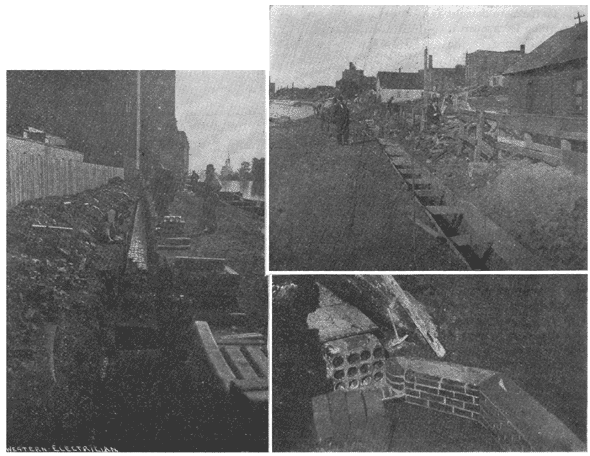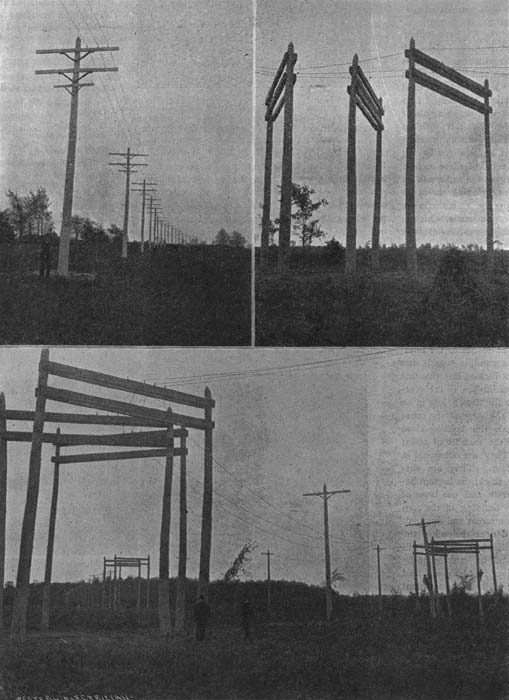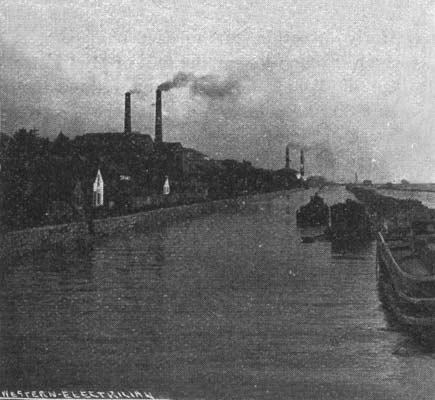[Trade Journal]
Publication: Western Electrician
Chicago, IL, United States
vol. 19, no. 18, p. 205-206, col. 1-3
Electric Power Transmission from
Niagara Falls to Buffalo.
BY ORRIN E. DUNLAP.
The transmission line which is to carry Niagara power to Buffalo is well nigh completed. This line is the property of the Niagara Falls Power company, and is about 26 miles long. For about 18 miles of this distance it runs through private property, the right of way purchased by the power company being 30 feet wide. For about five miles of the distance the line runs along the Erie Canal. The contract for the construction was placed with the White-Crosby company of Baltimore, and on August 14th work was commenced. So energetically has the company and its men labored that the work is now about completed, only the finishing touches yet remaining to be done. The superintendent of the work was John A. Wilson, and considerable credit is due to his ability for the rapid progress made. This transmission line is destined to prove another factor in drawing in closer touch the cities and villages between Lake Erie and the Falls of Niagara, for the mere thought of transmitting force over it lessens the distance to the extent of making them all seem one place.
| |||
| A Fine Section of the Pole Line. Turning A Corner. A Very Crooked Portion of the Pole Line. Electric Power Transmission From Niagara Falls to Buffalo. |
The Niagara Falls end of the line is at the transformer house adjoining the Niagara Falls Power Company's generating plant, and from this point it extends in an easterly direction along the north side of Adams avenue and over the property of the power company to a point 1 1/2 miles east of Sugar street. Here it leaves the line of Adams avenue and strikes out along the west side of and adjacent to the right of way of the Niagara Junction Railway company, and continues to a point about 500 feet north of the Mile Line road, when it turns at right angles and runs nearly due east through the power company's property to one mile north of La Salle. From this point it continues along the line of the old mile survey all the way to Tonawanda Creek. In doing this it follows closely the old line established in the closing years of the last century and re-established by old maps, notes and persons, and by a new map filed in the county clerk's office in Lockport. After crossing the Tonawanda Creek near Division street, in the village of North Tonawanda, the line continues in a Southerly direction over the right of way of the Buffalo, Thousand Islands & Portland railroad and along private property to the south line of the village, of North Tonawanda. This boundary line is followed about 1 1/4 miles in a westerly direction, where it again crosses private property in a northwesterly direction to the east bank of the Erie Canal, which it reaches near the foot of Hinds street, in the village of Tonawanda. It then follows the canal bank to Buffalo, the pole line meeting the conduit about 300 feet north of Brace street; and from this point to the power station of the Buffalo Street Railway company the cables will be laid underground, the distance being about 4,200 feet. In reaching Buffalo the line passes through the city of Niagara Falls, the town of Niagara, the town of Wheatfield, the village of North Tonawanda, the village of Tonawanda and the city of Buffalo, about 2 1/2 or three miles, however, being built in the last named place. All these places are in the counties of Niagara and Erie, the two counties first to receive the benefits of the Niagara development, but as the rights along the canal bank, which is state property, are obtained through the franchise granted by the state to the Cataract General Electric company, there is no telling to what extent the transmission is likely to be continued. It is apparent, however, that the Niagara-Buffalo line defines how easy it will be for many other towns and cities to be benefited by the transmission of Niagara power to their borders as a result of the action of the state in granting the Cataract General Electric company rights along the canal bank, for, as the right of way for the line will not have to be purchased, power can necessarily be delivered at less cost — a fact by which the people in the end should profit.
In traveling between the Falls and Buffalo, one catches an occasional glimpse of the pole line, and it is eagerly scanned by people anxious to know all about what is deemed a wonder for what it is destined to accomplish. The poles stand from 35 to 65 feet in height, and are all in place, about 200 men working in six gangs having been engaged in setting them under Superintendent Wilson's supervision. All of them are of white cedar and shaved. The pictures in connection with this article give an excellent idea of the manner in which the line is built. It will be seen that it is very substantial in all its parts, it having been a constant thought to give strength to it. The depth at which the poles are set is from six to eight feet. The ground along the line of transmission is for the greater part clay, and the larger number of the poles are just placed in the ground and well tamped. However, where soft soil was met the poles were set in concrete. In the construction of the present line the poles have been set to the east side of the center of the 30-foot strip, the outside line being one foot beyond the outside end of the large cross-arms. This was done so that another line of similar capacity could be built on the west side of the right of way should occasion demand it. The poles are set from 60 to 75 feet apart, the distance being varied in order to overcome any possible vibration of the spans. All the poles are to be painted with two coats of pure white lead and boiled linseed oil. In the transmission of the current from the Falls to Buffalo complete transposition is effected every five miles. At each of these five points on the line two poles which are five feet higher than those adjoining are set. In the picture entitled "A Very Crooked Portion of the Pole Line" one of these transposition points is shown, the first two poles appearing above the margin of the woods on the left being a set of the poles referred to. In turning sharp angles like corners six poles are used instead of three, and these are fitted with double cross-arms in order to distribute the strain of the cable on six instead of three pins. All poles set at angles are to be guyed to the bottom of the opposite poles by a three-fourth wire strand. All of the poles have three cross-arms. The two upper cross-arms are designed for power cables, and are of the same size, 12 feet long by 4 3/4 by 5 3/4 inches, and made of yellow pine. They are supported by solid braces made of two by two inch angle iron. The lower cross-arms are intended for telephone purposes. They are six feet long by 3 1/4 by 4 1/4 inches, and are supported by 1 1/2 by 1/4 inch angle iron braces. All the cross-arms are staggered, and the gains are painted before they are set. The double cross-arms used at corners and other angles are fastened by 3/4 by 10 inch lags and a three-fourths inch bolt through all parts. The upper cross-arms will carry iron pins on which galvanized barbed fence wire will be strung as a protection against lightning. This wire will be at a height of 18 inches and will be grounded at frequent intervals along the line. The pin holes in the cross-arms have a depth of four inches, and all are provided with drainage holes. All the pins are boiled in linseed oil and their butts painted. The pins are not nailed in position until after the double petticoated porcelain insulators are screwed on them.
The cable to be used on the pole line is a bare copper wire of 350,000 circular mils, and is furnished by the American Electrical Works of Providence, R. I. As the line is nearly 26 miles in length and three of these cables, or one three-phase system, are strung, the total length of cables used, in all, is about 78 miles. This cable was shipped to the work on reels weighing about 2,800 pounds, and containing about a half mile in length. The stringing of these cables was an interesting sight. The reels were loaded on a wagon having five feet four inch wheels and a tread of three inches. Heavy horses drew this load along as the cable was let out, a simple movement of a lever bringing the cable up taut on the poles. In connecting the ends the inner core is removed and a half connection made, which is soldered. As it glimmers in the bright sun, the cable is the object of much attention, owing to the part it is to take in transmitting Niagara's energy so many miles.
| |||
| Electric Power Transmission From Niagara Falls to Buffalo. Destination of the First Niagara Power to Be Transmitted to Buffalo, the Large Buildings at the Left Being the Buffalo Street Railway Plant. |
As heretofore mentioned, the transmission for the last 4,200 feet of the line will be through a conduit, which has been constructed along the canal bank in Buffalo. This conduit is constructed of 12 vitrified tile ducts, each having a diameter of three inches in the clear, and made by the H. B. Camp company of Aultman, Ohio. They are laid in concrete with four inches as the minimum protection on all sides. The conduit trench was excavated to a depth of about 40 inches, but this was governed by the locality. Eighteen inches is the average depth of the soil covering over the trench, and in no place does the conduit approach the edge of the canal bank nearer than 14 feet, the inside line holding close to the 16-foot mark. Manholes to the number of about 16 are located along the line. They are octagonal in form, with an interior of five feet. They are surrounded by a brick wall 12 inches thick, the bottom being formed by six inches of concrete and one layer of brick. The surplus earth in the building of the conduit was carried out in the river on scows and dumped. The terminal house is to be located near the end of the conduit, about 300 feet north of Brace street. It will be built of brick, 22 feet high, and an interior 16 by nine feet. A short tunnel about four feet long will lead from the last manhole in the conduit to the terminal house. The New York Safety Insulated Wire company will furnish the lead cable to be laid in the conduit, and the company guarantees it to stand a pressure of 20,000 volts. As it comes from the short tunnel this lead cable will be carried up on a trestle inside the terminal house, where the ends will be sealed, and from it a rubber insulated cable without lead covering will be carried out as tar as the first pole, a distance of about 20 feet, where it will be connected with the bare copper cable of the pole line. The terminal house will be fitted with lightning protectors The transformer house at the Niagara Falls end of the line stands on the opposite side of the inlet canal to the power house of the Niagara Falls Power company, and is now being equipped with the necessary transformers to raise the voltage of the current sent into it from the mammoth generators of the power house and speed it toward Buffalo. This work is being done under the careful supervision of W. A. Brackenridge, who is chief engineer of the Cataract Construction company. Mr. Brackenridge also has charge of the pole line work on behalf of the power company. The transformer station at the Buffalo end of the line will be located in the rear of the power house of the Buffalo Street Railway company. It will be 16 by 20 feet inside, and almost entirely underground. In this building the static transformers will be placed the rotaries being on the floor of the power station; Only three of the 12 ducts of the conduit will be occupied by the three first cables, the power company having made provision, both in the pole line and in the conduit, for more cables as the demand for Niagara power increases. The contract for the electrical equipment of the line is held by the General Electric company. The power to be sent to Buffalo will be generated by the big dynamos made by the Westinghouse Electric & Manufacturing company, three of which have been in operation at the Falls for some months.
 |
| An Uncovered Section of the Conduit in Buffalo. Lower End of Conduit Where Terminal House is to Be Built. End of the Conduit in A Manhole. Electric Power Transmission From Niagara Falls to Buffalo. |
While the transmission line is not straight in its course, its route is .perhaps as direct as could be expected considering its length and the many property owners the power company had to deal with in securing the right of way. Naturally some of them disliked to sell a strip 30 feet wide through the center of their farms, and this forced the line alone; the fences. Railroads built and some lines projected had to be avoided, and then the power company was desirous of securing a right of way with which nothing would interfere and one that it could carefully guard at all points and times. Before very long the entire work will be completed, and the people will witness the accomplishment of a result which not very long ago was pronounced impossible.
When it was first definitely ascertained and announced that the Niagara Falls Power company would invest in the development of the power available from the Niagara river, the project attracted world-wide comment and the work has ever since commanded attention. The victory scored by the power company in developing power in greater units than was ever before attempted has been a most notable one, and the steps to transmit this developed power are also the initial ones in this field, for in no place in the world is such a great amount of electric power transmitted. The company's effort stands unrivaled in its greatness, and it is possible that despite the hopeful, confident feeling of the locality directly interested, the people do not as yet recognize its full significance. At present the mind considers the cause of the current at the Falls end of the transmission, line and the effect in Buffalo, which is so immense, in its magnitude that the interests of the intervening territory are overlooked. But this should not be, for what the electric current of the line will accomplish in Buffalo it will also be able to do for every foot of land along the entire right of way, and thus nurse and bring the farms of to-day in closer touch with the industrial world and turn them into sites for factories which will extend from Buffalo to the Falls, all forming one great magnificent manufacturing city which shall be an everlasting monument to tell future generations what the Niagara Falls Power company has done.


